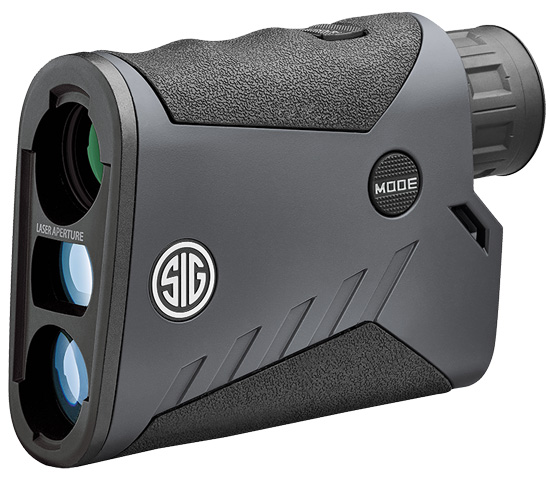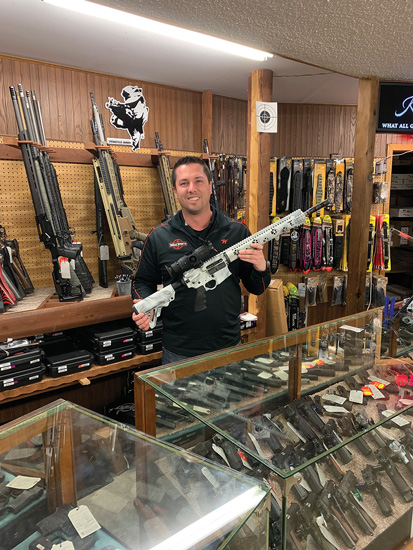Show And Tell
We’ve been hunting with firearms as long as there have been firearms. So, it’s probably no surprise when you find yourself dealing with customers who are perfectly happy to keep doing things the same way they’ve always done them. If things have worked in the past, why change?
And yet, manufacturers are constantly bringing new technologies into the hunting segment – particularly in the realm of optics and game cameras. So how do you convince veteran hunters to give these new gadgets a shot?
Consider the case of SIG SAUER’s Ballistic Data XChange (BDX) system, which uses a smartphone app to integrate the scope, rangefinder and ballistics information to offer the “most accurate and ethical shot.” But with a price tag capable of topping $1,000 — depending on the package — it can be a hard sell.
That’s been the experience at SoDak Sports in South Dakota, where owner AJ Hoffman said customer interest has cooled off after some initial hype.
“I’d have thought there would be a little more demand, but people aren’t too excited about them,” observed Hoffman, who has locations in Aberdeen and Mitchell.
Some of it he attributes to demographics. His hunters tend to be on the older side of his customer base. He sees the BDX system and similar new devices as being geared more toward younger, tech-savvy customers.
The story is similar at Walter Craig’s in Montgomery, Ala., though Store President Bo Hale is optimistic about the system’s future.
“It hasn’t caught on like I thought it would, but it will,” he said. “It’s becoming more and more popular as people start to understand what it means.”
The challenge is getting them to the point of understanding. His store’s technique seems to be helping with things like the BDX. Instead of relying on customers to learn about it on their own, Walter Craig’s takes a more active role in explaining the value of newer technologies.
They’ll mount the system onto a dummy stock and load the app and data into the customer’s smartphone. They step outside the store and let the customer test it at various distances so they can see for themselves what the system offers.
“It makes a big difference,” he added.
The same strategy works for showing customers why some scopes are so much more expensive than others. Nothing demonstrates the light-gathering quality of scope like stepping outdoors to see how they handle challenging light conditions. Even though his customers aren’t doing a lot of long-range hunting in Alabama, it doesn’t mean there’s no interest in the technologies making those long shots easier. Particularly for hunters planning excursions out west.
“If someone is going to spend $20,000 on a hunt, they don’t mind spending another $1,000 for a once-in-a-lifetime shot at a mule deer,” he offered.
In The Dark
Even though SoDak Sports’ customers may not have much interest in the BDX system, they still have a use for technological improvements, especially in thermal optics.
“That’s the ticket right now for guys hunting at night,” Hoffman said.
Top brands are Trijicon and Pulsar, with his stores keeping two to three units on hand at any time. It’s not an insignificant investment in inventory when you consider the units can fall in the range of $4,000 to $10,000.
“We aren’t selling them every day of the week, but we’ve sold a dozen units over the past three months,” Hoffman added.
Walter Craig’s has also seen rising popularity in thermal and night vision scopes, particularly from hunters and property owners looking to control the varmints threatening the local deer and turkey populations. Among the more popular brands are ATN, SIG SAUER and Leupold.
They also have a lower-priced option for hunters who don’t want to make a major investment. They stock thermal cameras by Seek — a $350–$400 option — that pairs with a cellphone instead of a scope. It won’t aid a hunter’s shot, but it will help them see what’s going on around them.
“They’re not good quality images, but they’ll help you locate your game,” Hale acknowledged.
Both shops also are seeing strong demand for game cameras from brands including Spypoint and Moultrie. Less-expensive models collect images on a disk and have to be accessed in person. But newer models use cellular service (costing about $15 a month) to stream images directly to the hunter.
“It’s not cheap, but it’s not horribly priced, either,” asserted Hoffman in South Dakota. “These game cameras are relatively easy to sell.”
One of the challenges with game cameras — along with thermal optics — is the market is constantly evolving with newer technology and rapidly falling prices.
“Whatever is new this year will be antiquated next year,” said Hale in Alabama. “We only buy what we know will sell this year.”
And how do you know exactly how many you’ll sell in a given year?
“It’s a sophisticated guess, and we’ve had some pretty spectacular flash sales at the end of the season because I guessed wrong,” Hale admitted.
But they’ve also turned some of those miscalculations into a marketing tool. They use some of their older thermal imaging scopes in a lease program and rent them out to hunters.
Long-Range Craze Continues
Considering SoDak Sports is based in the wide-open west, it’s not surprising long-range shooting has become increasingly popular there, driven further by the wildly successful 6.5 Creedmoor.
“It’s the biggest thing for our industry, outside of handguns,” Hoffman stated. “It’s the fastest growing segment of shooting sports.”
It helps there’s wide a range of quality offerings at various price points: “You can grab something off our shelves and be long-range shooting by the afternoon.”
Among other popular cartridges are the 6.5 PRC, 26 Nosler and 28 Nosler. Hoffman also sees a solid future for the 300 PRC: “It won’t be anything like the 6.5 Creedmoor. But then again, everything else is a drop in the bucket compared to it.”
Dedicated long-range customers are more likely to buy the chassis rifles by companies like Ruger and Christensen, but those hefty rifles aren’t going to be the top choices of hunters, he said. For a long day of hiking through the countryside, hunters are more likely to go for guns like the Browning X-Bolt or Tikka T3x.
Even in Alabama, where anything beyond 150 yards is rare, there’s growing interest in the category. If nothing else, there are local hunters planning trips out west.
Getting The Word Out
For Hoffman at SoDak Sports, the key is finding ways to get new stuff in front of customers. Most of the newer offerings are highlighted on Facebook, where they also have a weekly feature — Monday Gun Day — promoting new firearms. New scopes will get prominent real estate in display cases.
“If it’s anything new, you’ve got to push it out there in front of customers,” Hoffman advised.
This means Facebook, radio, TV and newspapers ads: “I’ve got billboards on the interstate,” he added.
And each year, they run a “Fall Hunting Spectacular” campaign highlighting hunting offerings, along with items from other departments throughout the store.
“There’s pretty much something from every department on sale,” Hoffman said. “It drives a lot of people in. It usually kicks off our fall.”
At Walter Craig’s, social media has become one of the major avenues for reaching current and potential customers.
“If we get some brand-new unicorn everyone’s looking for, we’ll showcase it,” Hale said.
The store also puts a significant emphasis on building relationships with its customers. At least once a month, they’ll host a special event highlighting some aspect of shop. In the fall, for example, they’re planning a shotgun range day involving several manufacturers. It’s the kind of event that takes a bit of creativity, considering the shop doesn’t have its own range. Instead, they have memberships at several local ranges, allowing them to take customers out for these special events.
For Hale, the value of the event won’t be measured in how many shotguns they end up selling that day. “It just gets them interested in the products we carry,” he said. “It’ll put feet in the door, even if they don’t buy anything then.”













